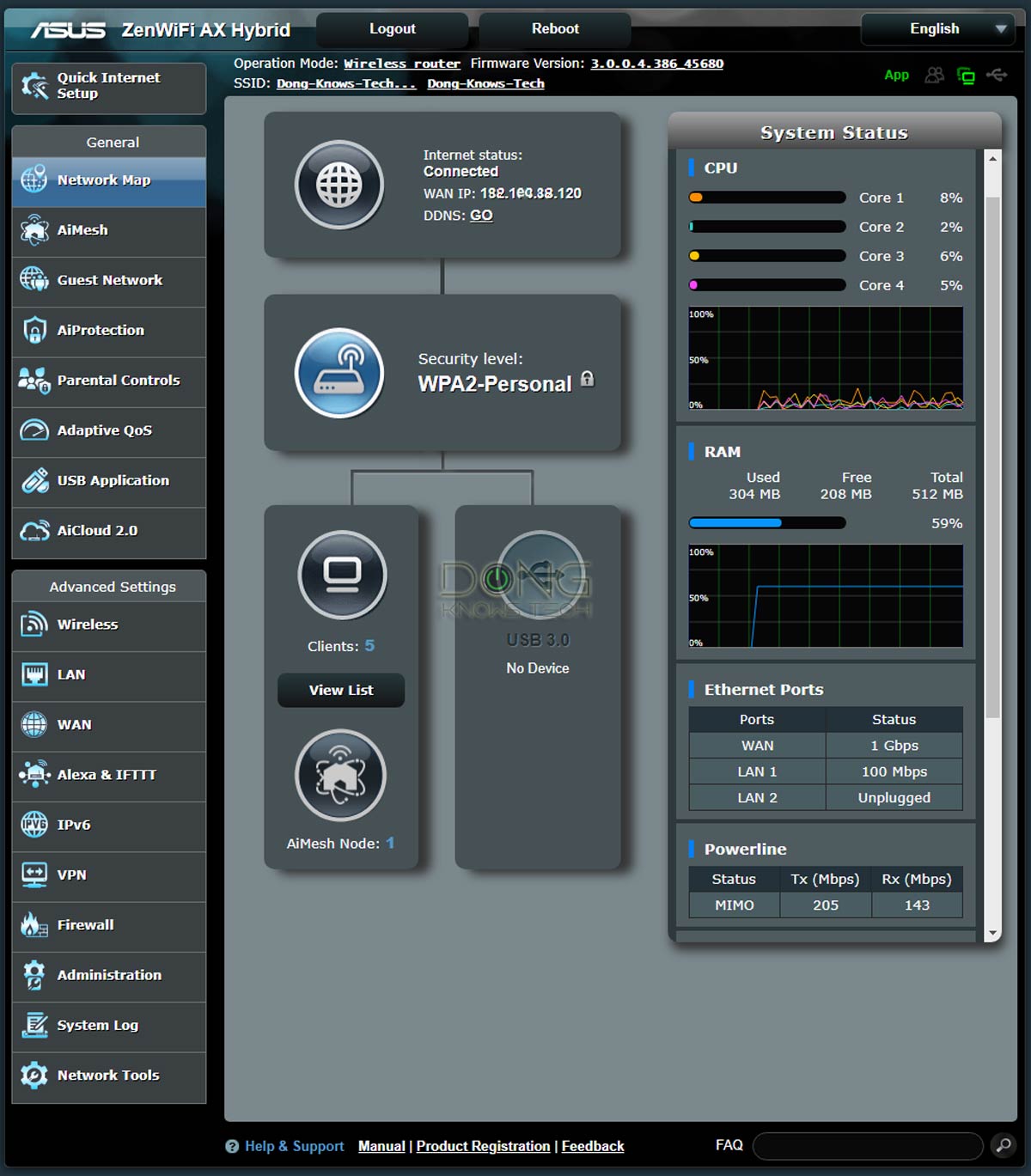Asus ZenWiFi AX Hybrid (XP4) Review: 1st Powerline AiMesh
[ad_1]
In more ways than one, the new ZenWiFi AX Hybrid (model XP4) is Asus’s Powerline alternative to its entry-level ZenWiFi AX Mini (XD4).
Specifically, the Asus XP4 is its older cousin, plus the built-in Powerline capability. And that makes a huge difference in their physical shapes and functionality.
Still, since I’ve already reviewed the XD4 and most of the existing solutions in the ZenWiFi family, this review will focus on what sets the XP4 apart from the herd, both the good and the bad. In a way, this is a ZenWiFi XP4 vs XD4 matchup.
But to cut to the chase, as in the case of most Dual-band AiMesh systems, if you have gotten your home wired, at $330 for a 2-pack, the ZenWiFi AX Hybrid XP4 can be an excellent buy, though in that case, you might want to get the ZenWiFi XD6 instead.
On the other hand, if you want to use it via wireless or Powerline backhaul, the result could be less than ideal and only suitable for those with modest bandwidth needs. In fact, I’d tentatively not count on the Powerline as backhaul at all.

Asus ZenWiFi AX Hybrid (XP4): Powerline (not) to the rescue
At the core, the XP4 shares the same concept as others in Asus’s ZenWiFi mesh family. It’s a 2-pack mesh system that consists of two identical dual-band routers — each can work as a standalone unit.
You pick one to be the main router and use the other as the satellite node that extends the Wi-Fi network. That’s generally how a Wi-Fi mesh system works.
No Multi-Gig, pre-sync hardware
Each XP4 router comes with a Gigabit WAN port and two Gigabit LAN ports. There’s no Multi-Gig port, which is always disappointing, though not a huge deal considering the mesh’s entry-level Wi-Fi specs.

Out of the box, you’ll note right away that the XP4s are a lot larger than the photos suggest. Sharing the similar “mini toaster” design, it’s about the same size as the much higher-end ZenWiFi ET8 — a bit taller and a tad narrower.
Like most ZenWiFi sets, the XP4’s hardware is pre-synced — you only need to set one up as a router, and the other will function as a mesh satellite unit once plugged into power.
And terms of hardware specs, it’s similar to the ZenWiFi Mini XD4, as you will see in the hardware specification table below.
However, the XP4 does have a couple of things over the older XD4, including:
- The USB 3.0 port: It can host a portable drive to work as a mini NAS server.
- The full support for AiProtection: It has everything, while the XD4 doesn’t have the 2-way Intrusion Prevention System (ISP) portion.
- The support for Dual-WAN.
The XP doesn’t have Link Aggregation, but that’s not a surprise considering its limited number of LAN ports. It also has the full support for AiMesh 2.0, which I detailed in this post. So, it has a lot of good stuff until you note its modest hardware specs.
Asus ZenWiFi AX Hybrid XP4 vs Mini XD4: Hardware specifications
The Asus XP4 and XD4 both are Dual-band mesh systems without the support for the 160 MHz channel width. As a result, they are entry-level in terms of Wi-Fi performance. Specifically, clients can connect at 1.2Gbps at best with sub-Gigabit sustained real-world rates.
| Full Name | Asus ZenWiFi AX Hybrid (XP4) |
Asus ZenWiFi AX Mini (XD4) |
| Hardware Models | XP4 | Router: XD4R Satellite: XD4N |
| Mesh Availability (as reviewed) |
2-pack (2x identical routers) |
3-pack (1x router + 2x satellites) |
| Built-in Powerline | HomePlug AV2, Up to 1300Mbps |
No |
| Wired Backhaul | Yes (Network port or Powerline) |
Yes (Network port) |
| Dimensions (WxDxH) | 7.99 x 5.83 x 2.76 inc (20.3 x 14.8 x 7.0 cm) |
3.54 x 3.54 x 3.14 inc (9.0 x 9.0 x 8.0 cm) |
| Weight | 1.47 lbs (666 g) |
Router: .65 lb (295 g) Satellite: .64 lb (290 g) |
| Wi-Fi Grade | Dual-band AX1800 | Dual-band AX1800 |
| 5GHz | 2×2 AX Up to 1200 Mbps (20/40/80MHz) |
2×2 AX Up to 1200 Mbps (20/40/80MHz) |
| 2.4GHz | 2 x 2 AX Up to 574 Mbps (20/40MHz) |
2 x 2 AX Up to 574 Mbps (20/40MHz) |
| Wi-Fi Security | WPA3 / WPA2 / WPA | WPA3 / WPA2 / WPA |
| Backward Compatibility | 802.11b/a/g/n/ac | 802.11b/a/g/n/ac |
| Mobile App | Asus Router | Asus Router |
| Web User Interface | Yes (Full) | Yes (Full) |
| AP Mode | Yes (As a single unit or system) |
Yes (As a single unit or system) |
| USB Port | 1x USB 3.0 | None |
| Gigabit Port | 1x WAN, 2x LAN |
Router: 1x WAN, 1x LAN Satellite: 1x LAN |
| Link Aggregation | No | No |
| Dual-WAN | Yes | No |
| Power Input/Output | AC Input: 110V~240V (50~60Hz), 1A | AC Input: 110V~240V (50~60Hz) DC Output: 12V, 1.5 A |
| Power Consumption (router unit, per 24 hours) |
179 Wh | Not tested |
| Firmware Version (at review) |
3.0.0.4.386_45680 | 3.0.0.4.386_25524 |
| Processing Power | 1.2GHz quad-core CPU, 256MB Flash, 512MB RAM |
Quad-core SoC CPU, 256MB Flash, 256MB RAM |
| US Price (at review) |
$329.99 | $399 |
First ZenWiFi mesh with built-in Powerline
The ZenWiFi AX Hybrid XP4 has something that’s never been available in Asus hardware — at least mong those available in eh US: The built-in support for Powerline.
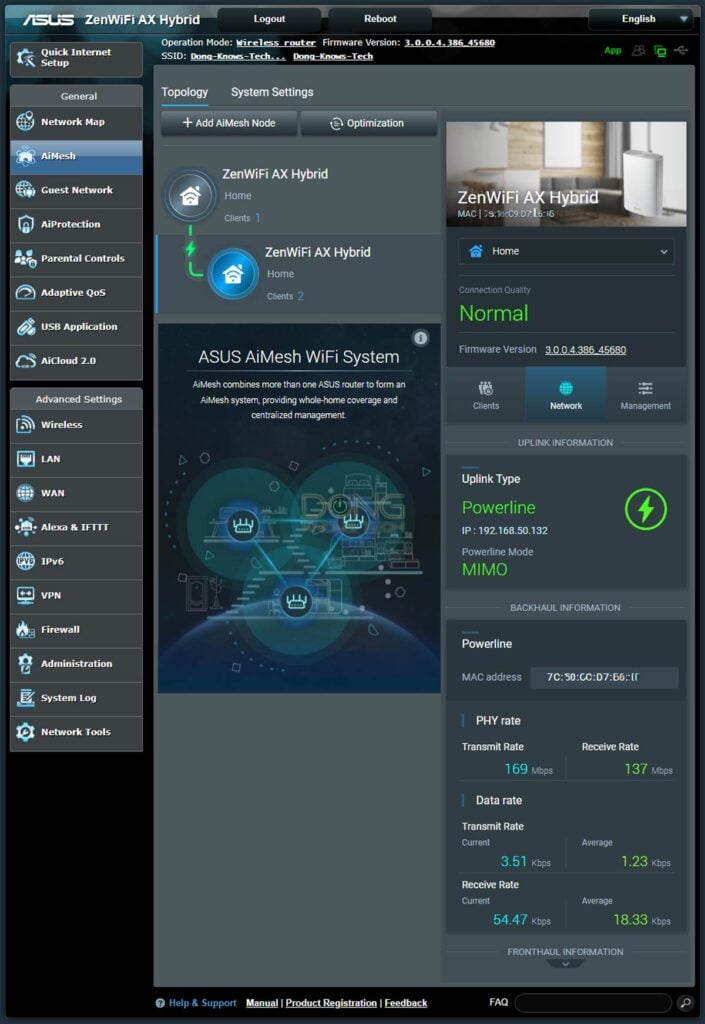
If you’re new, this post explained Powerline in detail. In a nutshell, each XP4 unit’s internal power supply incorporates a Powerline adapter, a.k.a power-line carrier or PLC.
When you plug both units into their wall sockets, there’s now a Powerline network connection between the two that can be used as the backhaul connection.
According to Asus, the XP4 features HomePlug AV2 MIMO capable of up to 1300Mbps. In reality, as the nature of Powerline, you’ll be lucky to get one-tenth of the speed — more in the performance section below.
Still, the XP4 has covered all aspects of backhauling, making it the most versatile. Specifically, you can use:
- Wi-Fi for backhaul.
- Wired backhaul (satellite’s WAN port to the router’s LAN).
- Powerline backhaul.
And for those living in a home with thick walls and no chance of running network cables, the Powerline backhaul might be an excellent alternative to wireless.
The way Powerline works, one of the routers must function as the primary (or master) node, which starts the Powerline network and connects all other nodes.
If you use just two units or wired backhaul, it doesn’t matter which works as the master, and you can leave it at “Auto.” However, the XP4 allows you to pick which of the two to have the role of the master PLC.
Like the case of all Powerline adapters, the XP4 is supposedly compatible with adapters from other vendors. In reality, like all Powerline adapters, it proved very hard to make third-party PLCs work with it.
Again, the two XP4 routers are pre-synced, so they’ll hook via Powerline right away out of the box. If you get extra units, there’s a button on the front to quickly sync them with the master unit — I haven’t tried.
However, if you use a third-party adapter, it can be a challenge to get it connected.
Asus ZenWiFi AX Hybrid XP4: Detail photos

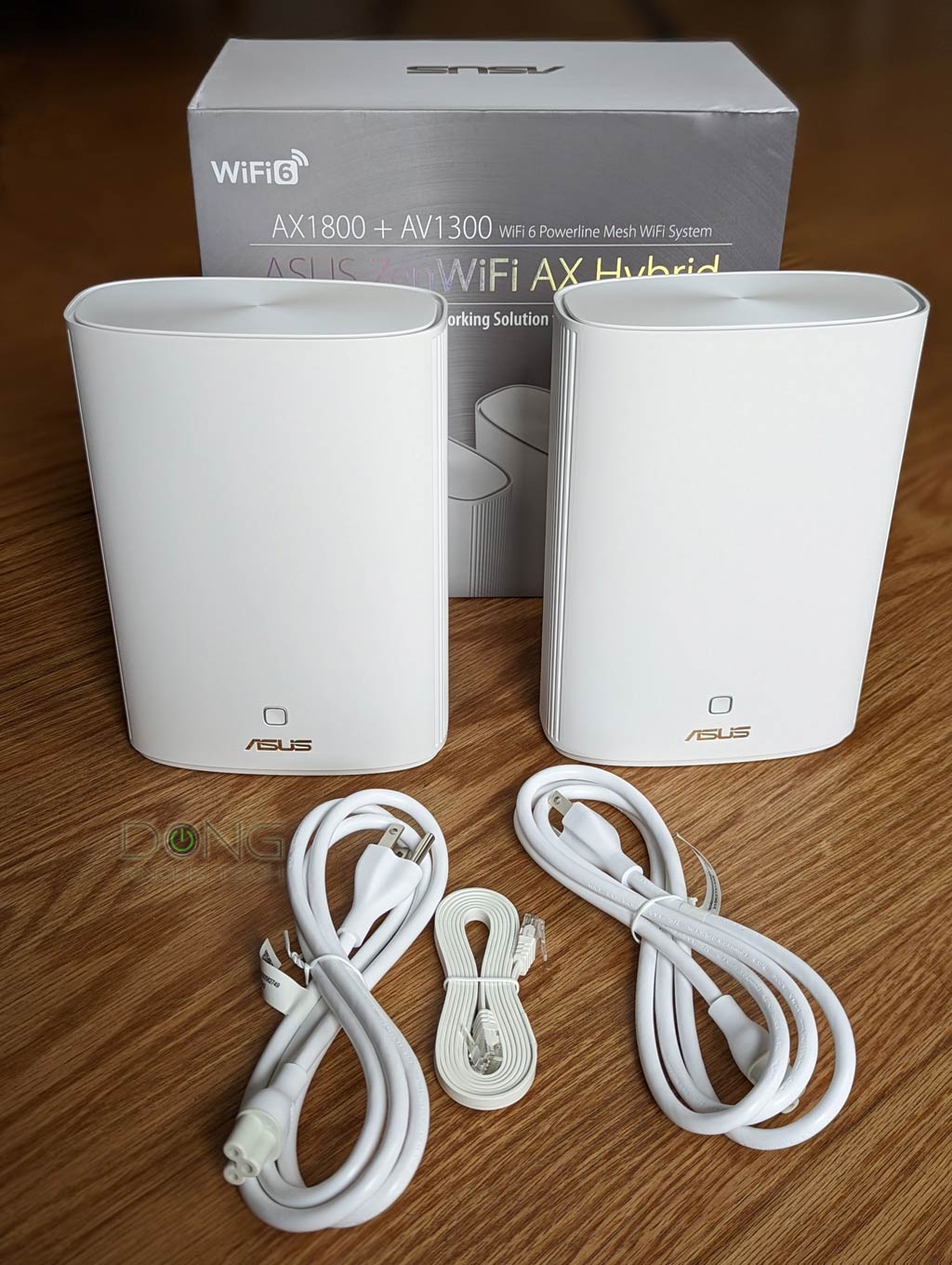
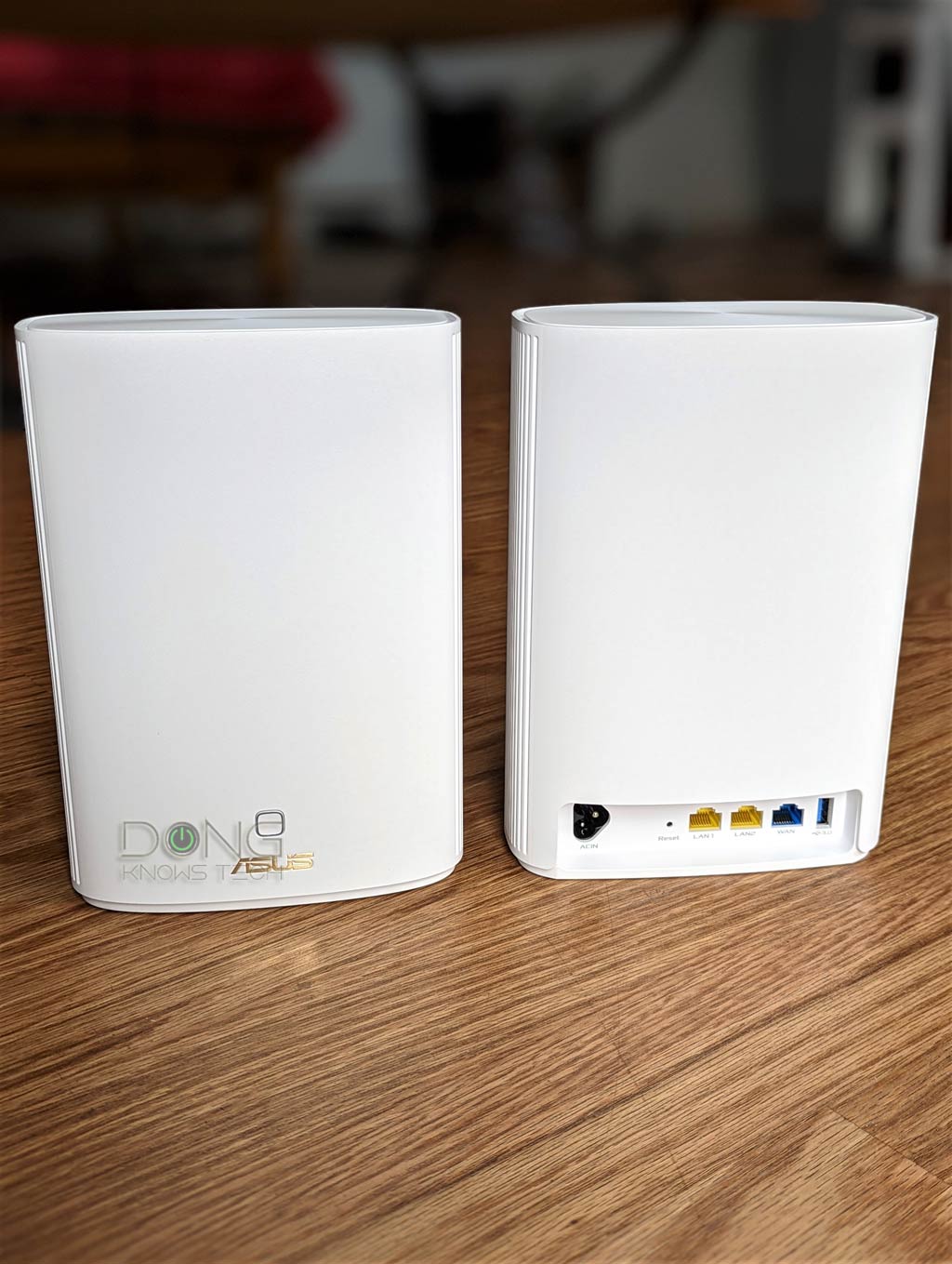


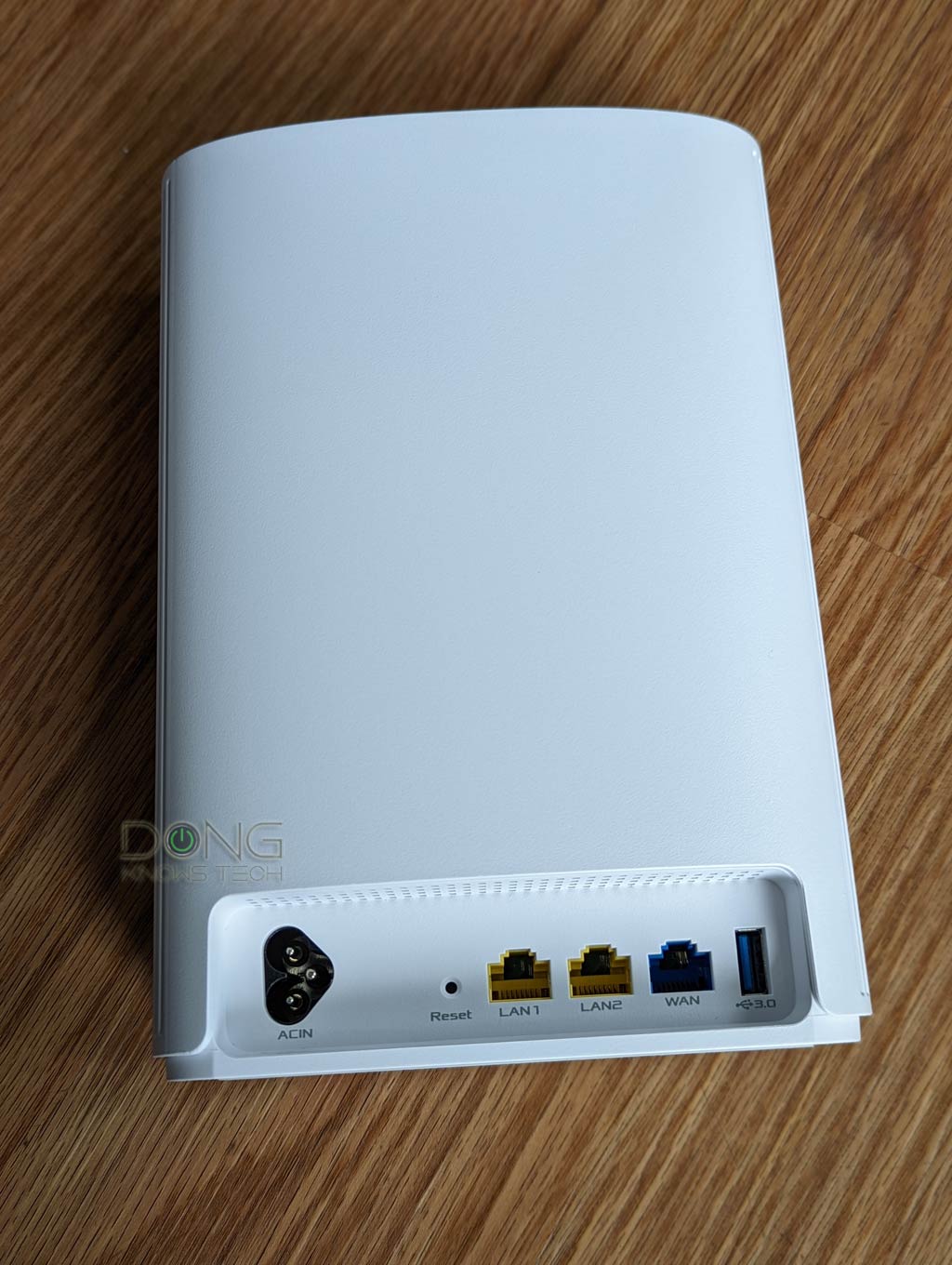



Almost all of Asus’s core router feature
Like the case of other ZenWiFi mesh sets, the ZenWiFi AX Hybrid XP4 supports the core features set of all Asus routers, except for the universal restoration.
Consequently, you can’t load a backup file of any other Asus router on it. That eliminates the convenience when you want to move from an older Asus router, but not necessarily a bad thing. Setting up a router from scratch is always the best for performance and stability.

As a mesh system, the XP4 will work just like any AiMesh hardware. If you have never used an AiMesh solution before, the extra content below will give you some highlights.
Extra: What you can expect from Asus’s AiMesh
This portion of extra content is part of the explainer post on AiMesh. Generally, you can expect the following out of your mesh system.
- Flexible backhaul: Starting with AiMesh 2.0 — available with firmware version 3.0.0.4.386.xxx later — an AiMesh system has flexible backhaul support. Specifically:
- Dedicated wireless backhaul: When you use traditional tri-band routers, like RT-AX92U, or GT-AX11000, one of its 5Ghz bands, the 5GHz-2, will work as the dedicated backhaul band by default — this band works solely as the wireless link between the router and satellite — not applicable when you mix Tri-band and Dual-band hardware or use wired backhaul.
- User-selectable backhaul: You can manually set any band (6GHz, 5GHz, or 2.4GHz) or network ports as backhaul priority. When left at Auto (default), the system will use the fastest band, for the distance between the main router and a particular satellite, as the backhaul. Auto also prioritizes wired backhaul (when available).
- Wired backhaul: Generally, the WAN port of the satellite unit must be used for backhaul. However, with a router that has a Multi-Gig LAN port (such as RT-AX86U or RT-AX89X), the high-speed port of the satellite node can be used for a Multi-Gig wired backhaul.
- Mixed backhaul: Generally, it’s best to use wired backhaul consistently throughout the system — you can daisy-chain the units. However, AiMesh does allow for mixing wired and wireless backhaul.
- Daisychain, third-party switch supported: For wired backhaul, you can daisy-chain the main router and nodes or use switches between the hardware units. For best performance, make sure you use Gigabit (or faster) unmanaged switches.
- Auto-sensing network ports: On the router unit, the WAN port functions in its designated role — it needs to connect to an Internet source. After that, the rest of the network ports in the mesh system, including the WAN ports on the satellite units (nodes), work as LANs. That’s generally true in either a wired- or a wireless-backhaul setup.
- Up to 10 hardware units: Asus says realistically, a system shouldn’t have more than seven units, though you can use up to 10, including the router. And I’ve indeed tried that many units in a wired backhaul setup with success. In a wireless configuration, though, I’d recommend no more than three hardware units, especially with dual-band hardware.
- No vendor account required: Just like any Asus router, no login account with Asus is necessary to use AiMesh, even when using the Asus Router mobile app. For remote access, Asus uses Dynamic DNS. So, AiMesh is less of a privacy risk (if at all) compared with other systems.
- Access point (AP) mode: As a system, an AiMesh setup can work in the access point mode — not to be confused with an individual router’s AP mode. In other words, you can use manage a few AiMesh hardware that works solely as Wi-Fi broadcasters on top of an existing (third-party) router. Among other things, it helps avoid the use of double NAT.
Like the case of all AiMesh routers, the ZenWiFi AX Hybrid XP4 can work as a system of its own, as two standalone routers, as the host for other AiMesh members, or as satellite nodes of an existing system hosted by another AiMesh router.
ZenWiFi AX Hybrid XP4: Interesting performance
I tested the ZenWiFi AX Hybrid XP4 for over a month in the following configuration:
- A single unit as a standalone router
- A 2-pack mesh via 5GHz backhaul
- A 2-pack mesh via the Powerline backhaul
All things considered, I was happy with it. But the system left a lot to be desired. It wasn’t a smooth ride.
A typical router and wireless mesh experience
As a single router, the XP4 performed as expected for its specs. With the Wi-Fi’s speed capping at 1.2Gbps theoretical, I was able to get the sustained speed of up to almost 750Mbps — well within expectations.

As a standard fully wireless mesh, the XP4 did well, too. As shown in the charts, it was fast enough for any home with a typical broadband connection.
The coverage was good, too, on par with the XD6 or even the ET8. The 2-pack could handle some 4000 ft2 (372 m2).
As usual, your mileage will vary. The more coverage you want, the slower the system will be. But the XP4 passed my week-long stress test with no disconnection.

So, as a typical mesh system, the ZenWiFi Hybrid XP4 proved, well, typical in my testing. But things changed when I used the Powerline as backhaul.
The slow and problematic Powerline backhaul
The first thing to note is the performance of the Powerline connection between the two-unit was much slower than the 1300Mbps ceiling speed of HomePlug AV2.
In my best-case scenario tests, where I plugged the two routers into two-socket of a newly wired office just a few feet apart, the Powerline connection sustained at 360Mbps.
Compared to other PLCs I’ve tested, that was quite decent, though not the fastest.
However, when I place the two units around the home in a realistic mesh setup, the Powerline connection is now sustained at just around 90Mbps at best, again quite typical among Powerline adapters.

And that brings just to the biggest issue with the XP4: If you leave its backhaul as “Auto,” which is the default, the system randomly switches between the 5GHz band and Powerline.
How frequently this takes place depends on the hardware arrangement, but generally, that’d happen more often than you’d like in a typical setup.
The switch itself will cause a brief disconnection. But most of all, the Powerline connection proved to be too slow and temperamental to work as the backhaul.
The takeaway on this front is not how bad the XP4 is but that we shouldn’t count Powerline as backhaul in a mesh system. It’ll work to a certain degree, but using network cable is a must if you want a reliable and well-performing network.
And the ZenWiFi Hybrid XP4 does support wired backhaul. In that case, you can expect the performance of the satellite unit to be the same as that of the router.
Decent NAS performance; reformatting required
The ZenWiFi XP4 worked well, for its specs, as a mini NAS server when hosting a portable SSD.
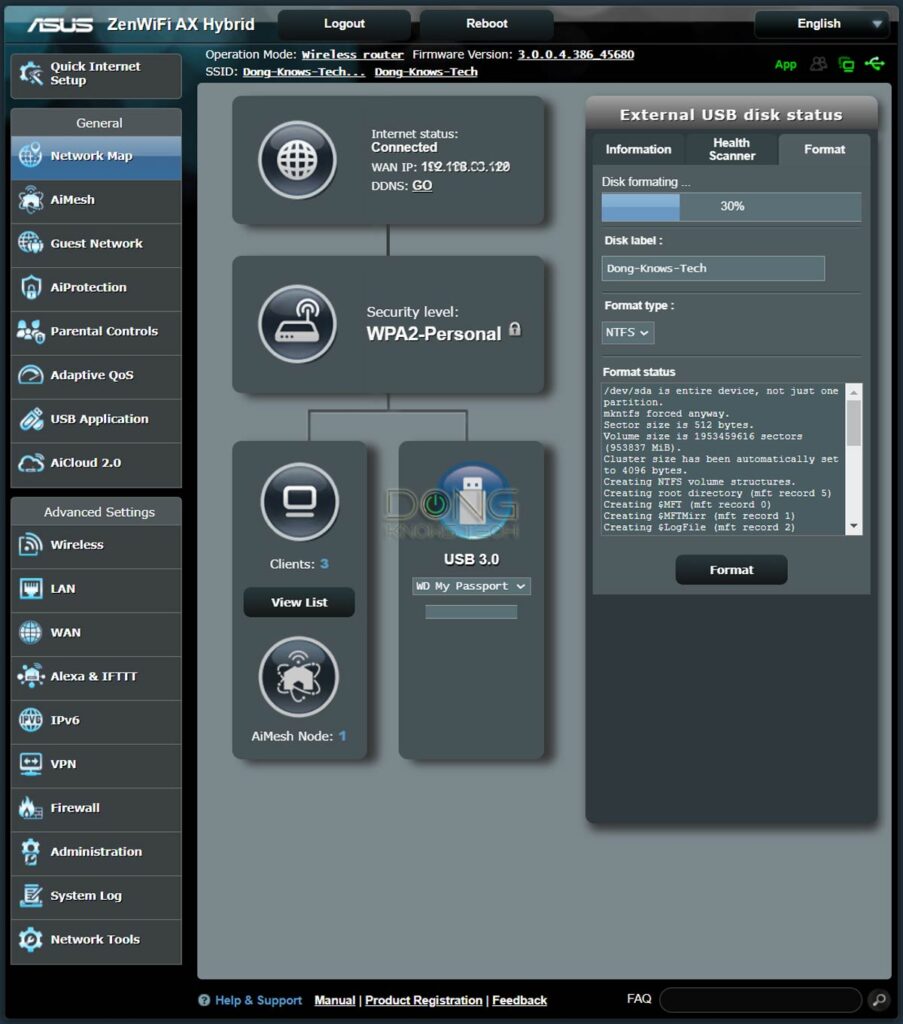
One thing to note: I needed to reformat the drive using the router’s web interface for this feature to work well. I tried multiple portable SSDs with existing data, and they all ran into connection issues until I used the router to format them.

Without a Multi-Gig LAN port, the ZenWiFi XP4’s network storage performance caps at 1Gbps, and via that connection, it delivers sustained copy speeds of almost 100MB/s and over 65MB/s for reading and writing, respectively.
Those were fast enough for casual network storage needs.

Pros
Reliable performance via wireless and wired backhaul
Excellent set of features, including full AiMesh 2.0, built-in Powerline support, pre-synced hardware
Cons
Temperamental and slow Powerline connection, no 160MHz channel width support
No Multi-Gig port or Link Aggregation
Only three network ports per router, not wall-mountable, a bit bulky
Conclusion
The Asus ZenWiFi AX Hybrid (XP4) has a big dilemma.
While the Powerline backhaul is likely the only reason you’d consider it, instead of a traditional dual-band system like the ZenWiFi XD4 or XD6, it’s also why you should avoid it. And that’s not necessary the mesh’s fault, but simply because of Powerline networking’s innate unreliable and slow nature.
That said, I’d recommend this mesh over the XD4 if:
- There are thick walls that block Wi-FI signals. And
- You can’t run network cables. And
- The home’s electrical wiring is suitable for Powerline.
Of those, #3 is hard to know beforehand and will vary greatly. But in the best-case scenario, keep in mind that the system can’t deliver more than a few hundred megabits of bandwidth — and Powerline is always Half-Duplex. Keep that in mind.
So, the Asus XP4 works best via the wired backhaul. And it also works well in a fully wireless setup — it does have to deal with signal loss, but that’s to be expected in all Dual-band Wi-Fi solutions.
But again, if you don’t need Powerline, there is almost no reason you shouldn’t pick the XD6 or XD4 instead.
Want to see other Wi-Fi solutions compared against each other? Check them all out here.
[ad_2]
Source link

